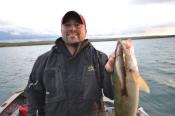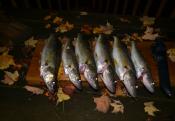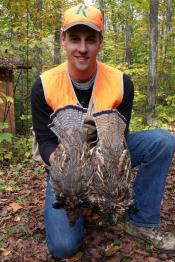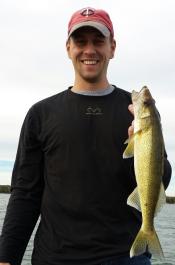 We’re just on the cusp of some great fishing, as numerous fronts are making their way through the Midwest while you read this. What I can tell you about the bite right “now,” is that it’s not quite ready. This past weekend near Grand Rapids, I found myself taking a trip north with a buddy to check out the walleye fishing, with the hopes of walking some forest roads for grouse as well. The forecast was bleak. For weather, we were looking at a Saturday with rain and wind throughout. In terms of fishing, water temps were pretty warm, 64-degree warm we later found out. On the hunting side of things, more bad news; grouse were at the bottom of their 10-year cycle, meaning our expectations were more along the lines of hoping to find any grouse, rather than planning on taking a few. However, outdoorsmen are optimists. We have to be, and we planned on making the best of it with everything from target-shooting to guitar-playing as backup plans.
We’re just on the cusp of some great fishing, as numerous fronts are making their way through the Midwest while you read this. What I can tell you about the bite right “now,” is that it’s not quite ready. This past weekend near Grand Rapids, I found myself taking a trip north with a buddy to check out the walleye fishing, with the hopes of walking some forest roads for grouse as well. The forecast was bleak. For weather, we were looking at a Saturday with rain and wind throughout. In terms of fishing, water temps were pretty warm, 64-degree warm we later found out. On the hunting side of things, more bad news; grouse were at the bottom of their 10-year cycle, meaning our expectations were more along the lines of hoping to find any grouse, rather than planning on taking a few. However, outdoorsmen are optimists. We have to be, and we planned on making the best of it with everything from target-shooting to guitar-playing as backup plans.
Fall walleye fishing to me, especially during this 60-degree mark, is a time of transition. At any time, you can expect several patterns to be possibilities, each calling for different tactics based on walleye location. Some fish move shallow, or never left shallow weedbeds, while others yet respond to mid-level depth breaks on structure, similar to where you’d find a June ‘eye. Others yet suspend or relate off the breaks in 30+FOW. Add to the mix some wind, and you can have several groups of fish going in different locations on different patterns in the same lake, making the part of choosing what you want to do quite difficult. Experience usually tells me to trust sonar while covering water and adjust on the fly as the lake gives up its clues throughout fishing.
 So we started by casting to some great rocks on wind-blown islands, though with water temps as high as they were, I wasn’t too confident in this approach. 30 minutes later we were pulling leadcore in the mid-level depths all the way out to 35FOW, along sandy, windblown sides of points. It was pretty apparent that fish were scattered and bottom-hugging in 30FOW or so, and we started picking up fish on 130 feet of Sufix 832 Advanced Leadcore, and #7 Shad Raps in Crawdad and Red Craw. Both of those colors are great in the fall, but eventually we picked off the active fish in the schools, leaving tight clusters of more inactive fish. Time for rigging some chubs. If there’s one fall tactic I really like more than most, it’s rigging big chubs, and with the graph laying out the way it did, slowing down and honing in on these inactive pods of stationary fish would be the only way to get them to bite.
So we started by casting to some great rocks on wind-blown islands, though with water temps as high as they were, I wasn’t too confident in this approach. 30 minutes later we were pulling leadcore in the mid-level depths all the way out to 35FOW, along sandy, windblown sides of points. It was pretty apparent that fish were scattered and bottom-hugging in 30FOW or so, and we started picking up fish on 130 feet of Sufix 832 Advanced Leadcore, and #7 Shad Raps in Crawdad and Red Craw. Both of those colors are great in the fall, but eventually we picked off the active fish in the schools, leaving tight clusters of more inactive fish. Time for rigging some chubs. If there’s one fall tactic I really like more than most, it’s rigging big chubs, and with the graph laying out the way it did, slowing down and honing in on these inactive pods of stationary fish would be the only way to get them to bite.
 Before leaving town, I went to a local creek and hook-and-line caught a few dozen chubs, which is something that isn’t as easy as you might think. Much like any fish, schools of chubs don’t take kindly to their buddies skipping over their heads as you put cast after cast past them. The general setup is an ice-fly below a bobber with a small chunk of crawler threaded on the hook. The two keys here are small chunk, and threaded. Too much bait and you’ll lose it in a second, don’t thread it, they’ll clean you out. A heavy tungsten ice-jig is preferable, because it stays down in current, and provides good resistance to the bobber. Chubs also live in some surprising places, and tend to prefer the vegetation that spills to the sides of the creeks more than the middle/open areas. It doesn’t have to be deep either. 1-2 feet of water is just fine. Another key to remember when catching chubs with hook-and-line, is to keep moving. 3 seconds of your bait in an area is more than enough time for them to decide to bite or not. Fish for these bait like you’re the most impatient 8-year old on the planet, and you’ll get to more spots, ultimately putting more bait in your bucket.
Before leaving town, I went to a local creek and hook-and-line caught a few dozen chubs, which is something that isn’t as easy as you might think. Much like any fish, schools of chubs don’t take kindly to their buddies skipping over their heads as you put cast after cast past them. The general setup is an ice-fly below a bobber with a small chunk of crawler threaded on the hook. The two keys here are small chunk, and threaded. Too much bait and you’ll lose it in a second, don’t thread it, they’ll clean you out. A heavy tungsten ice-jig is preferable, because it stays down in current, and provides good resistance to the bobber. Chubs also live in some surprising places, and tend to prefer the vegetation that spills to the sides of the creeks more than the middle/open areas. It doesn’t have to be deep either. 1-2 feet of water is just fine. Another key to remember when catching chubs with hook-and-line, is to keep moving. 3 seconds of your bait in an area is more than enough time for them to decide to bite or not. Fish for these bait like you’re the most impatient 8-year old on the planet, and you’ll get to more spots, ultimately putting more bait in your bucket.
 Back to the walleye fishing; my basic setup was a 3/4oz VMC Switch-it Slip Sinker on a 6 foot segment of 10lb Sufix Flourocarbon, attached to a 1/0-3/0 VMC Sure-Set Drop Shot Hook. The hook end is probably the most important part of the whole scenario, and I spied these hooks for the first time on the VMC Spin-Shot setup for bass anglers who love to drop-shot. When rigging chubs, I like a straight-point hook rather than curved or bird-beak style points so common on many of the Octopus hooks these days. I also prefer the thinnest wire hooks that are still beefy enough for the biggest eyes, and are made in large enough sizes to accommodate BIG chubs; make no mistake this is a big-fish tactic! I have some more testing yet to do, but I’m pretty sure I’ve found a winner, in that so few of the hooks I prefer for this technique are of the proper size, the proper weight/thickness, and with the proper point-style.
Back to the walleye fishing; my basic setup was a 3/4oz VMC Switch-it Slip Sinker on a 6 foot segment of 10lb Sufix Flourocarbon, attached to a 1/0-3/0 VMC Sure-Set Drop Shot Hook. The hook end is probably the most important part of the whole scenario, and I spied these hooks for the first time on the VMC Spin-Shot setup for bass anglers who love to drop-shot. When rigging chubs, I like a straight-point hook rather than curved or bird-beak style points so common on many of the Octopus hooks these days. I also prefer the thinnest wire hooks that are still beefy enough for the biggest eyes, and are made in large enough sizes to accommodate BIG chubs; make no mistake this is a big-fish tactic! I have some more testing yet to do, but I’m pretty sure I’ve found a winner, in that so few of the hooks I prefer for this technique are of the proper size, the proper weight/thickness, and with the proper point-style.
Fish started out just killing the chubs, but they weren’t the size we were looking for. That solid “smack” you get while rigging chubs is that walleye unleashing all of its predatorial instinct upon your bait, all at once. Still, they need to be big enough to get it down their gullet to the hook end! After giving these fish 30 seconds to a minute to take the bait, we hooked up about 50% of the time, mostly because of the smaller pods of eater fish that were trying to inhale a big chub. Either way, between the leadcore and rigging scenarios, we had a pretty potent 1-2 punch to finding active fish, then settling down on less active ones in getting them to eat. It wasn’t gangbusters, but it was steady, and a good break from walking the woods for grouse, which was also successful. We get out whenever we can these days, no matter the weather, the fishing conditions, or the population. I guess in the end while it’s nice to be parked smack-dab on top of a hot-bite, fishing and hunting when conditions aren’t tip-top is still far better than never having experienced it to begin with.
Joel
Here’s a few more from the woods and water.
Touched them all Joel Nelson!
PS I don’t remember the dinner invite.
Your report gave me something good to read over lunch hour!
It seems like its taking forever for the water to cool down this year. That’s a bad thing for those of us who are anxious to get the fall walleye bite rolling. It’s so close yet not quite here yet.
All in all though, it sure appears as though you guys did quite well despite the conditions. Certainly well enough to serve up some fillets and bird breast for supper!
Are those edible mushrooms or just good for pictures?
Nice story.
We were initially thinking them to be Porcini’s, which are highly edible and prized, as they look incredibly similar. Unfortunately, after some internet recon and research, they turned out to be some other unidentified fungus. Which is too bad, would’ve gone nicely with the grouse!
Joel
Wow that sure is a big chub in the first pic. Never thought of using bait that big for walleyes.
It doesn’t take a real big walleye to eat a chub that big. We use them in the fall, on the Black River, in central Wisconsin. Favorite method in the fall.
Great read, Joel – Love it! Cast and Blast, it’s finally fall!!
Informative and entertaining report. Thanks, Michael
Agreed completely, and that’s how I knew that alot of the fish we were missing were smaller. A good eye usually SMACKS that chub, to the point where you can’t re-use it even if you get it back. Chubs can flop around for a few minutes in the bottom of the boat and be lively still, but a good walleye smashes it as much as he smacks it.
Smaller fish pick it up, run with it, play with it, run some more. Usually I feel for the fish after 15 seconds or so and make my decision from there. When they’re on, it’s pretty quick. When they’re not, they can take some time to get to the hook.
Joel